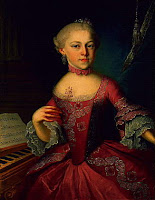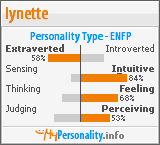Mozart's Sister: Maria Anna, "Nannerl"
>> Sunday, January 11, 2009

Maria Anna Mozart was a gifted musician whose abilities were quickly overshadowed by the achievements of her younger brother.
But at first, "Nannerl" was seen as the musical equivalent of Wolfgang, half of a sister-brother act that toured the capitals of Europe. As late as 1765 in London, she received top billing in concert advertisements written by her father. That soon changed, however, as the children grew older. Because he was the younger of the two -- and because he performed his own compositions -- Wolfgang became the star and Nannerl the supporting player.
Mozart thought highly of his sister's ability. In September 1781 he wrote to her from Vienna: ". . . believe me, you could earn a great deal of money in Vienna for example, by playing at private concerts and by giving piano lessons. You would be very much in demand -- and you would be well paid."
concerts and by giving piano lessons. You would be very much in demand -- and you would be well paid."
But it was not to be. Nannerl indeed became a piano teacher, but in "this dull Salzburg," as she called it. And in the wake of her brother's perceived rebellion, she surrendered control of her life to her father -- even her choice of suiters who, one by one, were turned away by Leopold. In 1784, she married the magistrate Johann Baptist Franz von Berchtold zu Sonnenburg (1736-1801) and moved to St. Gilgen -- but returned to Salzburg to give birth to her first son, and left the newborn there in Leopold's care.
Meanwhile, she grew more distant from Wolfgang, especially after his marriage to Constanze Weber. Their correspondence resumed briefly after Leopold's death. But by then their affection  for each other had all but disappeared; Mozart's brief letters to her deal almost exclusively with the disposition of their father's estate.
for each other had all but disappeared; Mozart's brief letters to her deal almost exclusively with the disposition of their father's estate.
After her husband's death, Maria Anna returned to Salzburg and supported herself once again by giving piano lessons. She died on October 29, 1829, and was buried in St. Peter's cemetery.
From The Mozart Project
The Concerto No. 10 in E-flat major for Two Pianos, K. 365, by Wolfgang Amadeus Mozart was written in 1779. Mozart wrote it to play with his sister Maria Anna (“Nannerl”). He was 23 years old and on the verge of leaving Salzburg for Vienna.
The concerto is scored for the two pianos together with two oboes, two bassoons; two horns; timpani; and strings. The piece is in three movements:
1. Allegro
2. Andante
3. Rondo: Allegro
The concerto departs from the usual solo piano concerto with the dialogue between the two pianos as they exchange musical ideas. Mozart divides up the more striking passages quite evenly between the two pianos. Also, the orchestra is rather more quiet than in Mozart's other piano concertos, leaving much of the music to the soloists.
The following performance is the third movement, Rondo: Allegro, of the Concerto No. 10 in E-flat for Two Pianos. Preformed by Pierre-Laurent Aimard, Tamara Stefanovich, and the Salzburg Camarata.




























2 comments:
Amazing!!!!!!!!!!!
Wow, this is new to me! Fascinating! Thanks, Lynette.
Post a Comment